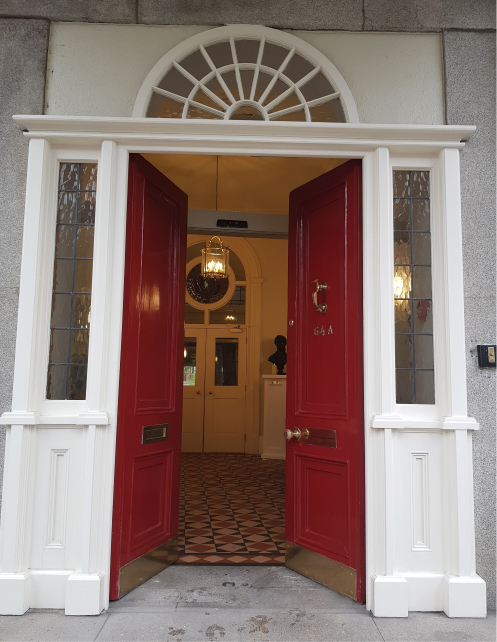Commemoration of Catherine’s life and death
In the Belgian city of Ghent is a 17th century baroque style house called the Seven Works of Mercy house. Its richly decorated upper façade is carved with relief panels of six corporeal Works of Mercy. Where is the seventh? The story handed down is that it is not depicted as it is lived out in the house.
There are no carved relief panels on this house where we gather this afternoon. From and in this house, the works of Mercy flowed into the lanes and streets of this city, throughout this country and the world through the life and vision of the woman whose 170th anniversary of death we celebrated today.From and in this house, the works of Mercy flowed into the lanes and streets of this city, throughout this country and the world through the life and vision of the woman whose 170th anniversary of death we celebrated today.
The Works of Mercy to which Catherine McAuley gave her life and resources are taken from the uncomfortable, teasing, turning-the-world-upside-down story we have just listened to and which Jesus told when “the disciples came to him privately, saying “Tell us, when will this be, and what will be the sign of your coming …” (Mt 24:3). Catherine recognised Jesus’ shocking identification of himself with the needy and the least ones whom he calls his sisters and brothers (25:40). This gives a new twist to being prepared for the unknown time of Jesus’ final coming which is explored in Mt 24-25.
170 years ago this evening surely Catherine heard: “Truly, I tell you, just as you did to one of the least of my brothers and sisters, you did to me” (vv. 40, 45). She had recognised that Jesus’ presence with the needy is an essential part of the vision of life in which Emmanuel, “God with us” (1:23) is in the community where two or three gather for worship as we do now (18:20) and with the Risen One until the end of time (28:20).
The significance to the following of Jesus in recognising him where he is not expected in the needy and least ones is found in the word Matthew uses to sum up all the actions. Jesus said: “They also will answer, “Lord, when was it that we saw you hungry or thirsty or a stranger or naked or in prison, and did not minster (diakonein) to you?” (v.44). Some bible translations have “take care of you.” However, there is one word used minister (diakonein) for all the actions. This is the verb which sums up the mission of Jesus “who came not to be ministered to but to minister” (20:28). It describes the action done to Jesus by the angels who minister to him in the desert (4:11) and also by the women and men disciples who minister to him (8:15, 27:55).
In the ancient world, diakonein and words from it are not used in ordinary life but in the religious sphere. Early Christians seem to have taken this term to describe a central aspect of their lives. The basic idea is an activity of an in-between kind and is associated generally with one who is called to represent and speak on behalf of another. We find in this Catherine’s desire to connect those who are rich with those who are poor which is the focus of the Mercy International Association vision statement.
The six areas described in the gospel passage would have been the needs of the majority of a city such as Antioch where most likely Matthew was written. Crowded living conditions, lack of sanitation, inadequate and uneven food supply, sewage problems, epidemics and disease, general poverty, need and debt – the reality, too, of Catherine’s Dublin, the reality of millions in our time.
Six “Works of Mercy” areas are named in the parable but these are not exhaustive. In the Catholic tradition, all concerns, spiritual and temporal, are contained within these. Catherine built this House to shelter young servant women at risk. To address causes of their predicament, not only did she set up schools for education in life skills but integral was education in their faith. So too in our age, alongside the corporate works of mercy we embrace the spiritual works of mercy, such as education which the Aotearoa New Zealand poet James K. Baxter expresses aptly as “Tell other ignorant people what you in your ignorance think you know.” For example, we educate the spiritual and theological imagination to bring into dialogue the Christian tradition and new scientific understandings of the universe and the interconnectedness of all life.
Our reading from Mary Sullivan (Tradition of Mercy, 133) highlights two symbols which speak of Catherine’s death. The first is the burning of her boots. In this final act of abandonment of herself to God, Catherine accepted the end of her walking. She turned barefooted before her God whom she was not afraid to meet in death because she had recognised God’s presence in her ministering (diakonein) to the poor,She turned barefooted before her God whom she was not afraid to meet in death because she had recognised God’s presence in her ministering (diakonein) to the poor, to whom she gave her life and resources, over whom she transcended her own preference to remain a lay woman and formed a religious congregation – us - to ensure this ministering (diakonein) continues.
About five o’clock in the evening on this day 170 years ago in her room on the second floor, Catherine “asked for the candle to be placed in her hand.” The candle, the ancient symbol of the presence of the risen Christ, which she grasped in her hands entrusting “all she had created and animated to the care of God and of her ‘darling’ companions” is the second symbol of Catherine’s death. She surrendered all, as her life which had burnt brilliantly and silently, as a steadily burning lamp flickered out. We, too, are her “darling” companions whom our first reading from II Timothy reminds “to stir into flame the gift of” (1:6) mercy she had lit among us.
The decision is ours as we are reminded in a story told about an old king who had two sons and wanted to name one of them as his successor. He summoned them and gave each five pieces of silver saying: “With this money, and before night-fall, you must fill the great audience chamber of the palace. With what you fill it is your own decision.” The elder son passed a field where workmen were cutting sugar-cane. After the grinding in the mill the crushed cane was thrown to the ground. “Ah,” thought the son, “these useless husks could be used to fill my father’s audience-chamber.” He arranged just that. At night fall, the younger son arrived. The crushed cane was removed. He, then, placed a candle in the centre of audience-chamber and lit it. Its light filled the chamber and reached into even its farthest corners. The king declared, “You will be my successor. Your brother spent his silver filling this chamber with useless waste. Without needing even one piece of silver, you have filled it completely with light. You have filled it completely with what people most need.”
“With what you will fill it is your own decision.” What decisions do I make? Do I fill the audience-chambers of our world with useless husks purchased by misspending resources? Or do I, and we as Catherine’s congregation, light a candle which fills the audience-chambers of our world with what people most need - the freely available Light of God’s mercy, in its many expressions, which reaches even to the farthest corners?


)
)
)